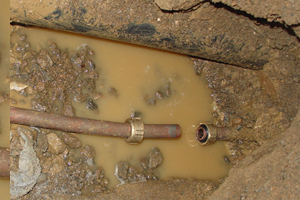
Most buildings in San Diego use slab-on-grade construction for their first floors. These thick concrete slabs provide a solid foundation perfectly matched to our climate, at low cost. But they do pose slab leak repair problems for any plumbing underneath them. Whether water supply line, interior hot and cold pipes, or sewer lines, any leaks are hidden under several inches of concrete, plus flooring materials above that. A water leak can go undetected for quite some time, and even become fairly large, without your even knowing it.
But make no mistake, an un-repaired slab leak will lead to major damage sooner or later. Moisture from trapped water can lead to various types of water damage. Plus even small amounts of slowly flowing water can undermine the foundation leading to uneven settling and cracks throughout the building’s structure.
Do I Have a Slab Leak?
Determining that you do indeed need slab leak repair is often a process of elimination. Have you experienced an increase in water usage, sudden or gradual, that seems to have no explanation? That is to say, you haven’t changed or added any water-using appliances… no change of tenants, visitors or new family members… no change in the daily routine… yet water use is up and there’s no obvious leaks at fixtures or connections.
It’s always a good idea to be on the lookout for discoloration and unusual moist areas as well as hot or cold spots on floors, walls, and ceilings as an indication of a hidden water leak. After a while you may notice mold or odors, or even cracks in the walls or ceiling. Prompt diagnosis and repair always reduces overall costs; the more severe the symptoms the more likely major repair and restoration will be needed.
You can also determine if you have a leak by shutting off all water users and monitoring your water meter for a few hours. But it’s better to call in a well-trained professional plumber. They can perform a much more sensitive pressure test, confirm that there’s no leaks at any fixture or exposed plumbing, and track down any leaks within walls, ceilings, and crawl spaces.
Finding the Exact Location
Once you know that you have a slab leak, it’s critical to determine precisely where it’s located. Repair often involves removing flooring materials and then chipping a fairly large hole through the concrete slab. It can be expensive just getting to the leak, and restoring the floor involves even more expense. Plus all that work is going to disrupt your home life or business operations. With modern technology there’s simply no excuse for making one hole after another in attempts to locate the problem.
ASAP Drain Guys & Plumbing employs leak detection specialists. Besides a skilled eye developed through years of experience, we’re equipped with the latest and best equipment for detecting and localizing leaks. In fact, we have a variety of technologies to draw from, including very sensitive electronic moisture and humidity meters. Locating an under-slab leak is much the same as finding a shallow underground leak, so we may also employ electronic gear based on electromagnetic detection. Acoustic detection and location pressurizes the pipe with an inert gas, and your plumber then probes for the hiss of escaping gas using special microphones. Digital thermal imaging cameras that use infrared light allow us to see temperature differences of a tiny fraction of one degree. This lets us quickly scan an area, and then zero in on anything that looks suspicious.
Slab Repair Options
Depending on the nature of the leak, on the building’s plumbing, and on the building itself, you’ll have one or more options for slab leak repair. An ASAP professional will take the time to explain the ins and outs of each in an easily understood way, and provide up-front pricing. That way you can make an informed decision before proceeding.
Spot Repair
If the problem is readily accessible and the building’s plumbing is otherwise in good condition, a spot repair may be the most economical solution for a slab leak. As mentioned above, we’ll break through the floor slab and repair the spot that’s leaking. Since the repair will soon be under concrete again, it’s vital to replace that section of pipe with the absolute best in materials and workmanship rather than making any sort of patch.
Rerouting and Repiping
In other situations, such as when the under-slab pipes are old or in poor condition, it’s better to disconnect the existing line and install new pipes that route outside the slab foundation and then back inside the building.
Pipe Lining
When the problem is a small “pinhole” leak and there is a likelihood of more in the future, pipe lining can be a cost-effective and permanent solution. Here a cure-in-place epoxy, similar to that used in high-quality plastic pipes, is used to coat the insides of the pipes under the floor slab.

